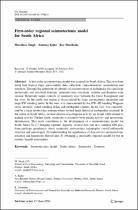JavaScript is disabled for your browser. Some features of this site may not work without it.
- ResearchSpace
- →
- Research Publications/Outputs
- →
- Journal Articles
- →
- View Item
| dc.contributor.author |
Singh, M

|
|
| dc.contributor.author |
Kijko, A

|
|
| dc.contributor.author |
Durrheim, R

|
|
| dc.date.accessioned | 2012-01-17T08:53:21Z | |
| dc.date.available | 2012-01-17T08:53:21Z | |
| dc.date.issued | 2011-10 | |
| dc.identifier.citation | Singh, M, Kijko, A and Durrheim, R. 2011. First-order regional seismotectonic model for South Africa. Natural Hazards, Vol 59(1), pp 383-400 | en_US |
| dc.identifier.issn | 0921-030X | |
| dc.identifier.uri | http://www.ingentaconnect.com/content/klu/nhaz/2011/00000059/00000001/00009762 | |
| dc.identifier.uri | http://hdl.handle.net/10204/5497 | |
| dc.description | Copyright: 2011 Springer. This is the post print version of the work. The definitive version is published in Natural Hazards, Vol 59(1), pp 383-400 | en_US |
| dc.description.abstract | A first-order seismotectonic model was created for South Africa. This was done using four logical steps: geoscientific data collection, characterisation, assimilation and zonation. Through the definition of subunits of concentrations of earthquake foci and large neotectonic and structural domains, seismotectonic structures, systems and domains were created. Relatively larger controls of seismicity exist between the Great Escarpment and the coast. In the south, this region is characterised by large aeromagnetic anomalies and large EW trending faults. In the west, it is characterised by the NW–SE trending Wegener stress anomaly, radial-trending dykes and earthquake clusters. In the east, it is characterised by a large neotectonic domain where several large historical earthquakes occurred. In the centre of South Africa, several clusters of earthquake activity are found, often related to mining activity. Further north, seismicity is related to both mining activity and neotectonic deformation. This work contributes to the development of a seismotectonic model for South Africa by (1) bringing together, digitally, several data sets in a common GIS platform (geology, geophysics, stress, seismicity, neotectonics,topography, crustal and mantle structure and anisotropy), (2) understanding the significance of data sets for seismotectonic zonation and limitations thereof and (3) obtaining a reasonable regional model for use in seismic hazard assessments. | en_US |
| dc.language.iso | en | en_US |
| dc.publisher | Springer | en_US |
| dc.relation.ispartofseries | Workflow request;7864 | |
| dc.subject | Seismotectonic models | en_US |
| dc.subject | Seismicity | en_US |
| dc.subject | Zonation | en_US |
| dc.subject | South African seismotectonic model | en_US |
| dc.subject | Regional seismotectonic models | en_US |
| dc.subject | Natural hazards | en_US |
| dc.title | First-order regional seismotectonic model for South Africa | en_US |
| dc.type | Article | en_US |
| dc.identifier.apacitation | Singh, M., Kijko, A., & Durrheim, R. (2011). First-order regional seismotectonic model for South Africa. http://hdl.handle.net/10204/5497 | en_ZA |
| dc.identifier.chicagocitation | Singh, M, A Kijko, and R Durrheim "First-order regional seismotectonic model for South Africa." (2011) http://hdl.handle.net/10204/5497 | en_ZA |
| dc.identifier.vancouvercitation | Singh M, Kijko A, Durrheim R. First-order regional seismotectonic model for South Africa. 2011; http://hdl.handle.net/10204/5497. | en_ZA |
| dc.identifier.ris | TY - Article AU - Singh, M AU - Kijko, A AU - Durrheim, R AB - A first-order seismotectonic model was created for South Africa. This was done using four logical steps: geoscientific data collection, characterisation, assimilation and zonation. Through the definition of subunits of concentrations of earthquake foci and large neotectonic and structural domains, seismotectonic structures, systems and domains were created. Relatively larger controls of seismicity exist between the Great Escarpment and the coast. In the south, this region is characterised by large aeromagnetic anomalies and large EW trending faults. In the west, it is characterised by the NW–SE trending Wegener stress anomaly, radial-trending dykes and earthquake clusters. In the east, it is characterised by a large neotectonic domain where several large historical earthquakes occurred. In the centre of South Africa, several clusters of earthquake activity are found, often related to mining activity. Further north, seismicity is related to both mining activity and neotectonic deformation. This work contributes to the development of a seismotectonic model for South Africa by (1) bringing together, digitally, several data sets in a common GIS platform (geology, geophysics, stress, seismicity, neotectonics,topography, crustal and mantle structure and anisotropy), (2) understanding the significance of data sets for seismotectonic zonation and limitations thereof and (3) obtaining a reasonable regional model for use in seismic hazard assessments. DA - 2011-10 DB - ResearchSpace DP - CSIR KW - Seismotectonic models KW - Seismicity KW - Zonation KW - South African seismotectonic model KW - Regional seismotectonic models KW - Natural hazards LK - https://researchspace.csir.co.za PY - 2011 SM - 0921-030X T1 - First-order regional seismotectonic model for South Africa TI - First-order regional seismotectonic model for South Africa UR - http://hdl.handle.net/10204/5497 ER - | en_ZA |






